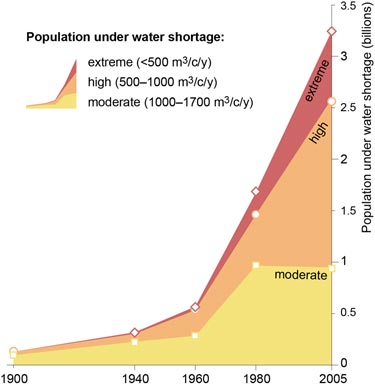Sep 7, 2010
Over the past 2000 years, population increase has been four times more significant than climate change in the rise of water shortage. That’s according to researchers from Finland and The Netherlands, who have analysed population growth, climate data and water-resource availability.
“Moderate water shortage first appeared around 1800, but it commenced in earnest from about 1900 when 2% of the world population experienced chronic water shortage ([with access to] less than 1000 cubic m/capita/year),” Matti Kummu of Aalto University, Finland, told environmentalresearchweb. “Water shortage increased extremely rapidly from 1960 onward, with the proportion of the global population living under chronic water shortage increasing from 9%, or 280 million people, in 1960 to 35% (2,300 million) in 2005.”
Kummu and colleagues from Aalto University and Vreije Universiteit Amsterdam in the Netherlands used the HYDE dataset on global population along with the ECBilt-CLIO-VECODE climate model and STREAM hydrological model to indicate past water availability. They then produced a water-crowding index for 284 food-producing units.
Developed by the International Food Policy Research Institute and International Water Management Institute, food-producing units are a hybrid of river basins and economic regions. This is the first water-scarcity study to use the units.
“The pace of growth of water scarcity – which according to our analysis is very rapid in many geographically large and highly populated regions of the planet – is striking,” said Kummu. “Our results, which are illustrated with global geographic maps, may, we hope, bring about public awareness and boost political will on tackling water scarcity.”
The researchers believe that their findings provide important insights on how water shortage has developed in different parts of the world. Understanding these past developments could help create future projections.
“In Eastern Asia and North Africa, over 20% of the population has been under some level of water shortage since the year 1900,” said Kummu. “In the Middle East, this point was not reached until 1960, and in South Asia slightly later. In South Asia the trend has been particular sharp as today over 90% of the population are under some level of water shortage.”
As water has become more scarce, people have used adaptation techniques such as the construction of reservoirs, irrigation and abstraction of groundwater.
“Our study reinforces the view that there are already several regions in which such measures are no longer sufficient, as there is simply not enough water available,” said Kummu. “Consequently, there will be an increasing need for non-structural measures, focusing on increasing the efficiency of water use, lowering water use intensity, reforming the economic structure of countries or entire regions, and optimising virtual water flows from regions without shortage to regions with shortage.”
Virtual water is water used to produce goods, food or electricity imported from one country to another.
Now the researchers will assess in more detail how physical water scarcity has developed since 1900 as well as how it is likely to change by 2100, along with scientists from the University of Kassel, Germany.
“In macro-level analyses such as ours, water shortage is usually defined as the water availability per capita over a time period such as one year,” said Kummu. “It would be, however, highly beneficial to develop the approach to include more detailed estimations of the historical evolution of water demand and the dynamics of water availability. Our aim is consequently to assess both population-driven and demand-driven physical water scarcities for 1900-2100.”
The team reported its work in Environmental Research Letters(ERL).
About the author
Liz Kalaugher is editor of environmentalresearchweb.


No comments:
Post a Comment